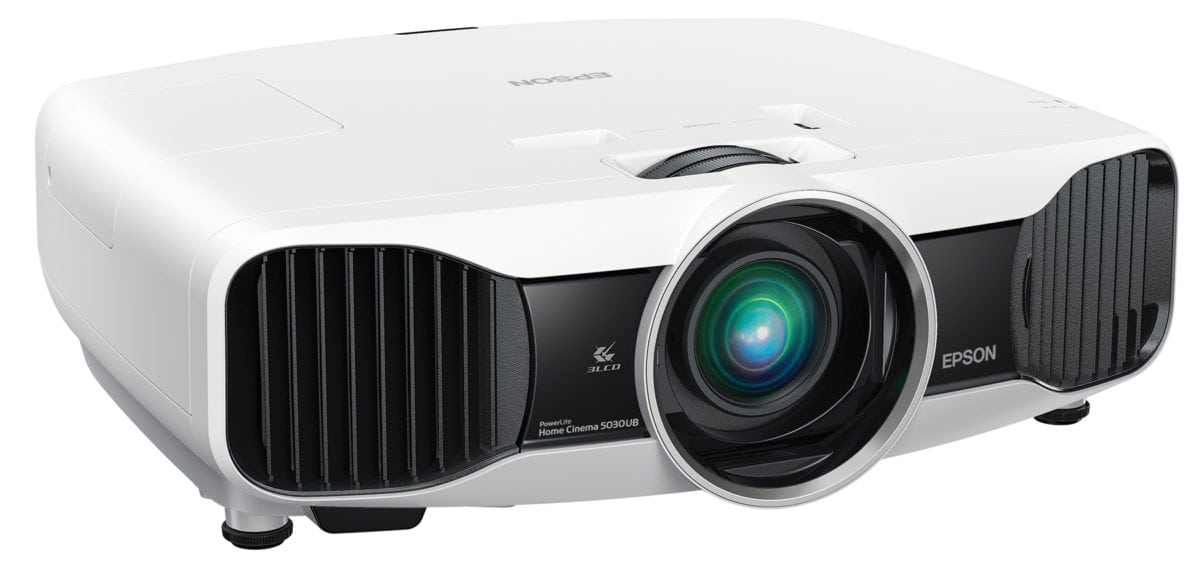Here, we will compare two competitive home theater projectors, the Epson HC 5030 and the Panasonic PT-AE8000U.
Comparing the Epson HC5030 and the Panasonic PT-AE8000U
The 5030UB and the AE8000U are two inherently similar projectors - they share the same LCD panels, similar in size, similar in zoom lens, and lens shift as far as placement flexibility goes. Both are ultra high contrast projectors, but on the opposite ends of the that spectrum. Warranties and support are very different. Brightness very close, a major change from two years ago when the Epson was clearly the brighter by a very significant margin.
-

The Epson Home Cinema 5030 UB
Below, we will discuss how this projector compares to the Panasonic PT-AE8000U.
-

The Panasonic PT-AE8000U
Below, we will discuss how this projector compares to the Epson Home Cinema 5030UB.
Comparison Images
Epson’s Home Cinema 5030UB (and Pro Cinema 6030UB) are a year newer than the Panasonic. As a result, not having had the Panasonic here in a year, the side by side comparison images above are the Panasonic (left) and the older HC5020UB (right).
Comparing Operational Cost
Both claim the same lamp life, but Panasonic charges $379 compared to $299 per lamp.
Comparing Warranty
Warranty: The hidden cost. We know most folks don’t give warranty differences much thought, even though we do. (We know that the warranty page is always the one least read, in every home projector review.) In this case, the Warranty differences have the potential to affect long-term cost and convenience. Both have two years, but Panasonic limits their two-year warranty to 2000 hours. That means anyone who remotely sees himself/herself as a heavy user (let’s say more than 20 hours a week), such as those who use their projectors as a primary “TV”, is going to run out of warranty before the two years are up. A very heavy user like (when I’m not reviewing) – my usage is similar to the national average for TV viewing – upward of 40 hours a week. That means that for folks with usage like mine (and there are a lot of us), the warranty might not even last one full year. But the Epson has another advantage Epson will immediately replace any projector that is suffering from a warranty problem, by shipping right out (within 1 business day) a replacement which you keep), they pay the freight, including to get your busted one back. Basically: a great warranty and minimal hassle. Warranty is a clear and important advantage for Epson. It means nothing if you never have a problem, but their replacement program will prove awesome for those who aren’t lucky, and need warranty service!
Comparing Picture Quality
Both calibrate well, and are similar in terms of color in best mode, and also similar after slightly improving both of their brightest modes. Skin tones are excellent on both post calibration, but this year’s calibration of the 5030 UB, looks better than what the Panasonic PT-AE8000 was capable of last year. The PT-AE8000U also tends to have a softer, and a touch less contrasty (pop) look than the Epson, but that tends to be personal choice. It’s the black levels and dark shadow detail where the Epson proved superior. The Epson does better dark shadow (not by much). But there’s no contest, the Epson is truly superior on dark scenes, thanks to its noticeably better black level performance! I should note that Panasonic does sometimes reveal a little more detail in the lighter ranges. (For example compare the detail of the river water, in the night train scene, but again, that’s last year’s Epson)
The Epson simply looks visibly better on dark scenes, thanks primarily to the black level advantage, which will give you the feel of a lot more pop to the image. While that may not mean much on a typical bright scene, as we all know, other than sporting events, there are usually plenty of dark scenes in most other content, especially movies, and plenty of HDTV. (How many vampire shows are out there?)
Comparing Special Features: Lens Memory vs. Picture in Picture
Lens memory let’s you use a 2.35:1 screen instead of the usual 16:9. That’s great for folks who primarily watch movies. As I’ve learned, I like the wide screen, but hate that my sports are so much smaller, with my wide screen. I’m flexible, I’m getting an even bigger 16:9 screen for my sports. If you don’t care about smaller HDTV, etc. and you really want to not have to see letter boxing on those widescreen movies consider a 2.35:1 screen, then the Panasonic is your clear choice. The Epson with it’s manual zoom lens simply can’t have a way to use a widescreen short of an anamorphic lens and outboard processor (buy the Pro Cinema 6030UB in that case, as it supports anamorphic lenses with two modes, so that no outboard sled is needed). Thus for those wanting 2.35:1, the Panasonic is the practical and affordable choice. Split screen is gone from the Epson this year, replaced with Picture In Picture, which can work with two HDMI sources. Panasonic has nothing like that. If you can’t live without Picture In Picture, then the Epson is for you. Other than those two special features, you have a real choice.
Comparing 3D
Two years back I considered the Panasonic to be the clear winner in terms of 3D. True, it wasn’t as bright, but that Epson would not allow their dynamic features to work in 3D – the dynamic iris, CFI, and no Super-Resolution… put it at a distinct disadvantage for 3D. This year, the most important by far, of those dynamic features – the Dynamic Iris and Reality Creation are available in 3D The Epson for example, goes from seriously inferior blacks two years back (in 3D) to easily superior blacks this year in 3D… The Home Cinema 5030 UB this year, now allows virtually all dynamic features to work in 3D, more than last year. The Panasonic’s 3D may actually be a touch more precise than the Epson’s due to some extra parallex correction, but what they are doing is hard to spot. The real difference is 3D brightness. While the PT-AE8000 pretty much closed the gap on 2D brightness, it’s no contest, the Epson is very visibly brighter in 3D. Whether its the glasses, the processing… no matter, they are not close in brightness when viewing 3D comparing both in their brightest modes, which is where you probably want to be unless you have a really smaller screen.
The Bottom Line
Bottom line: I definitely think the Epson Home Cinema 5030 UB and Pro Cinema 6030 UB have the overall advantage picture wise, with the blacks are the key reason for that. Also though, this year’s 5030UB calibrated and produced a more natural, accurate image than the 5020 UB that I used for the only direct comparisons a year ago. The Epsons also have real wins in 3D (due to brightness), warranty and support.
 Click Image to Enlarge
Click Image to EnlargeThe Panasonic is the winner if you want an anamorphic shaped screen, thanks to lens memory. It’s also got cool features – the Waveform monitor and side by side image analysis. Regarding that, ultimately, it’s estimated that less than 10% of people use wide screens, and most of those are owners of some very expensive projectors, equipped with anamorphic lenses and sleds, and they are probably viewing in some very classy home theaters where the owners have spent far more for seating than both of these projectors cost combined. (I’m talking about projectors from Runco, SIM2, and throw in Sony’s $24,999 VW1100ES and $14,999 VW600ES, their two true 4K home theater projectors.) Other than lens memory, placement flexibility is essentially a tie.
From a personal note, I would pick the Epson for my personal use, but once again, I can fully understand why many choose the Panasonic. Like Brightness, Size matters. In this case, I’m talking the size of the price tag. Even at the same price, everyone’s going to line up with a favorite of the two, but keep that wallet in mind. The Epson is currently $400 less, and that can jump to $600 if the Panny glasses promo goes away. In years past – really until last year, it was usually the Epson that cost a few hundred more. With the Epson being a serious chunk of change less expensive, and still a bit brighter calibrated, and in 3D, it would seem that if you can live without lens memory that the Home Cinema 5030 UB is the better value proposition of the two. Enough!












